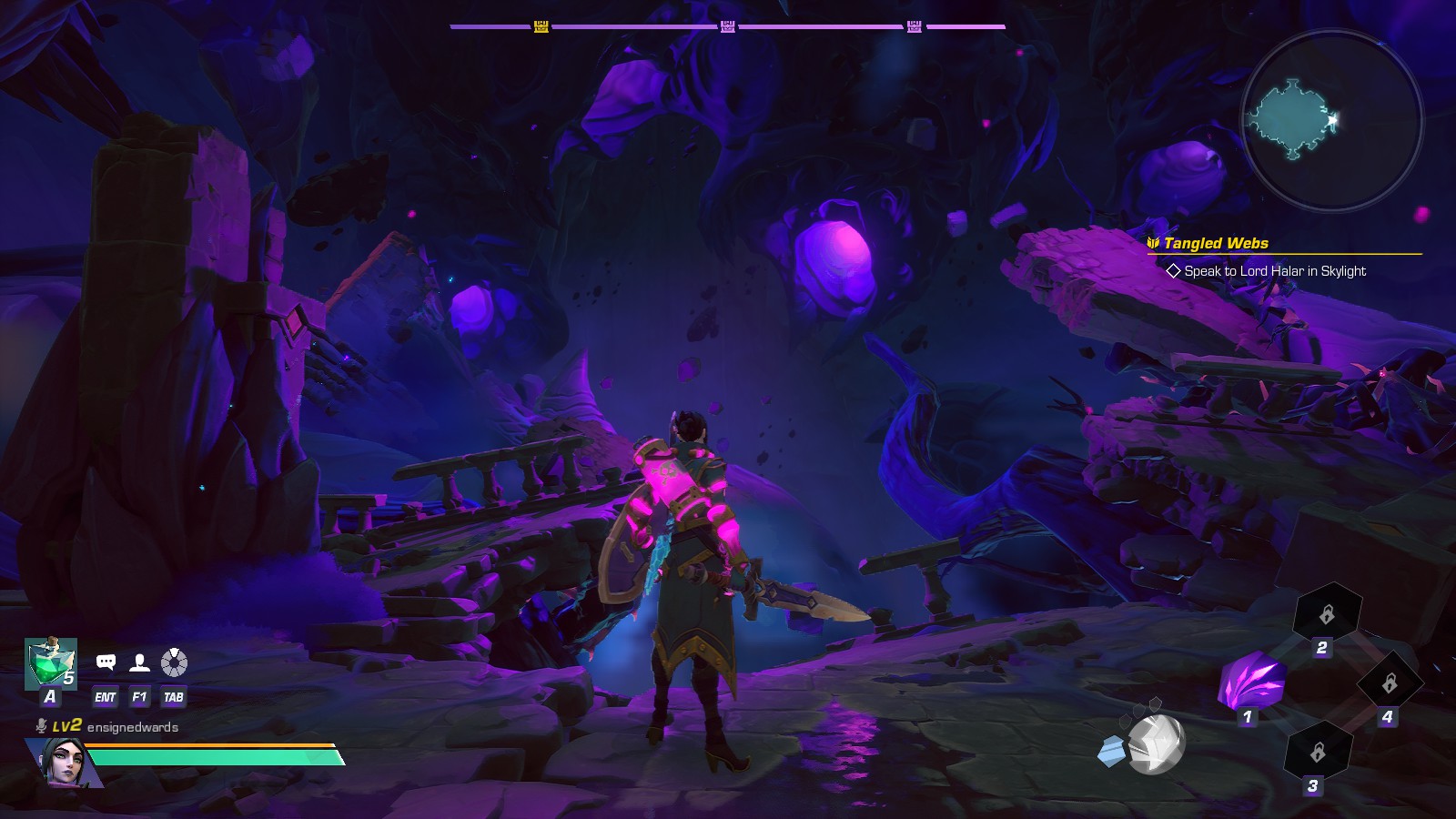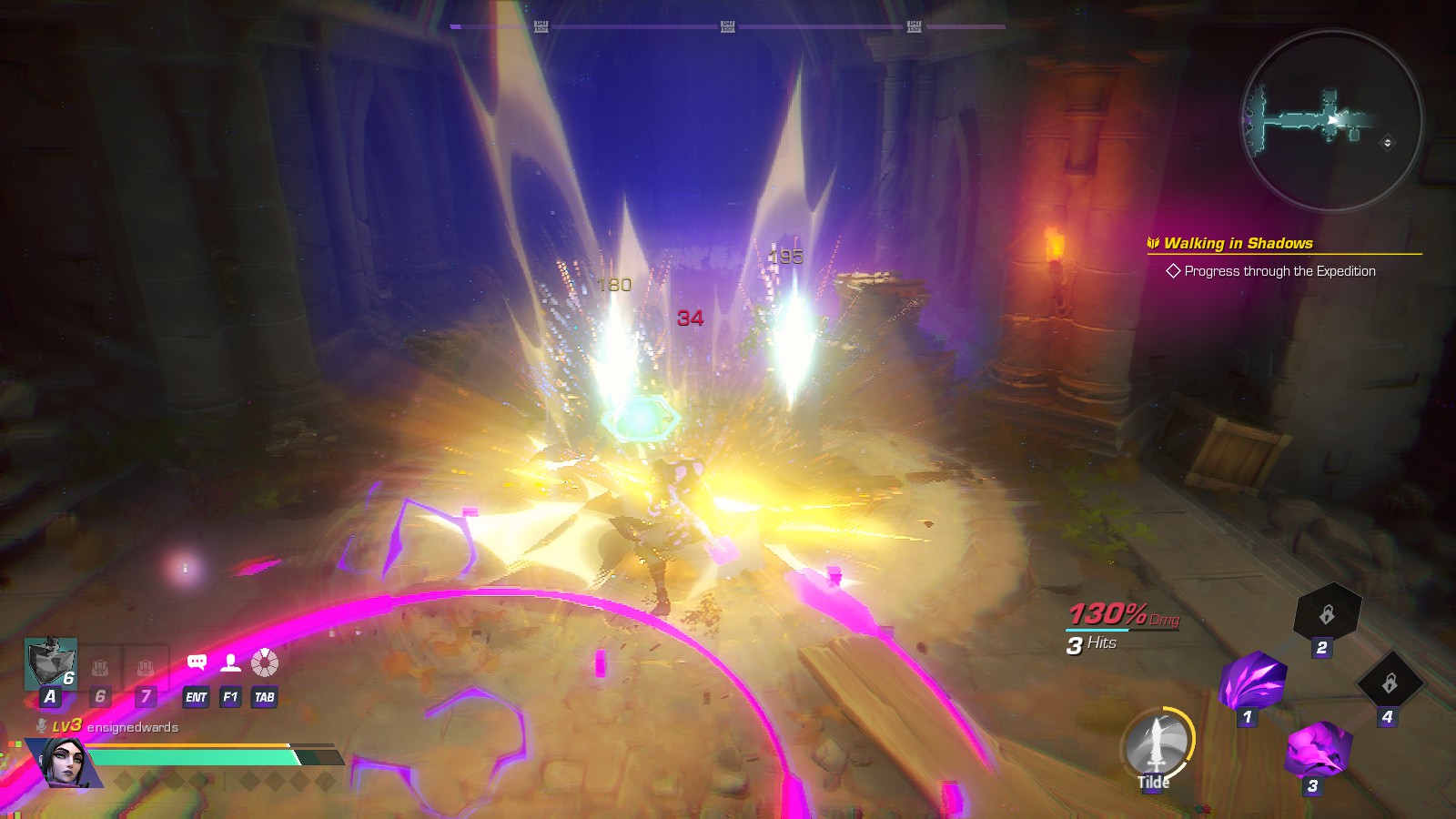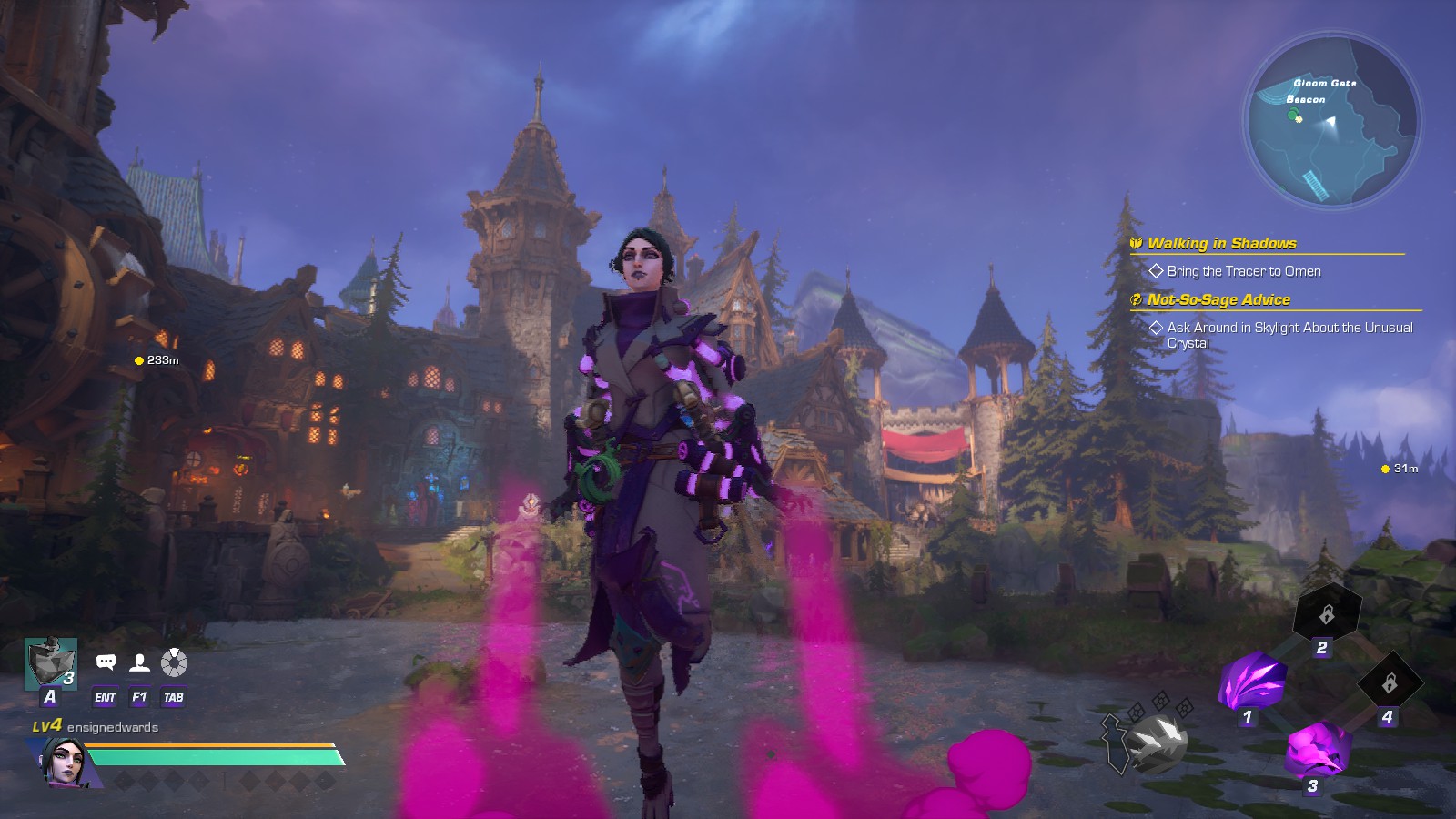
Over the past few days, I have spent many hours waiting in Wayfinder‘s seemingly endless queues. But what of the game at the end of that queue? Is Wayfinder worth the Waitfinder?
Having managed to play for a few hours now, I think the answer is a definitive, “Eh… maybe?”
Off the bat, Wayfinder didn’t leave a great impression with a fairly dry, lengthy tutorial. There’s quite a lot of running around between various NPCs as they lay out the game’s lore and basic mechanics.
A talky introduction can be OK if the talking is interesting, but that’s not the case here. The dialogue and voice acting are pretty listless. The concept of a world slowly being swallowed by the elemental chaos of the Gloom is intriguing in theory, but it’s laid out so blandly as to remove any sense of wonder.
The colourful art style of Wayfinder has been much praised in the lead-up to release, but in practice I had mixed feelings on it. Some of the environments are very pretty, but it’s got a weird mix of being cartoony yet detailed that can lead to some visual clutter and uncanny valley effects.
There’s also been some controversy around Wayfinder‘s decision to eschew custom characters in favour of preset characters, the titular Wayfinders. It does feel a bit odd to see half a dozen other versions of yourself running around, but I’m mostly OK with it in theory, if you can make the characters feel exciting enough.

A game with a set cast really needs to knock it out of the park on character design, both when it comes to aesthetics and gameplay. It needs to make the characters so cool you don’t miss the option to make your own. Overwatch is really good at this, with nearly every character having a very distinctive look and playstyle that feels unique not just in the context of the own game but also in the genre as a whole.
I’m not sure Wayfinder has managed the same. Most of the current cast feel very uninspired and generic — a heroic paladin, an edgy rogue, a beefy barbarian…
I initially chose Niss, a character who seemed designed for my tastes specifically. A brooding Dark Elf rogue with a tragic backstory? There’s nothing about that combination of words I don’t like. But even so, I ultimately found Niss pretty underwhelming. Her aesthetics and lore are very cliche, and her gameplay lacks any kind of wow factor. “Oh, she has a dash attack, and her ultimate lets her dash more often. That’s… fine, I guess…”
Because developer kindly Airship Syndicate granted press previewers the highest tier of founder pack, I could quickly access other Wayfinders, and I later switched to Venomess, a character who focuses on DoTs and healing, and I enjoyed her gameplay a lot more, though her look was giving me serious “dollar store Widowmaker” vibes.
Wayfinder‘s roadmap does mention character-specific story missions, which is a pretty neat idea that could help give them some more personality when the missions arrive. Right now in early access, they’re not doing enough to get you invested in your chosen Wayfinder.

Aside from picking a character, your next most important choice is deciding which weapon you’ll wield. Any character can wield any weapon, but at least some Wayfinders do have toolkits geared toward certain playstyles. You can use a ranged weapon as Niss, but it feels like you’d be working against most of her kit. Currently the weapons are a mix of melee and guns, with no bows or magical options. Weapons can have significantly different mechanics, and each weapon has an active ability to supplement the abilities of your Wayfinder.
I found weapons to be an area of great frustration. Without exception, they are overly complex, fiddly, and unintuitive. Each weapon has multiple paragraphs of text to explain their various mechanics. Some let you block, some only let your parry, some don’t do either. There’s also combo chains with light and heavy attacks — and unlike every other game of this sort I’ve ever played, Wayfinder ensures that heavy attacks are not activated by holding down light attack but instead have a totally separate keybind. It’s a lot to manage.
Some weapons add further wrinkles still. Guns offer a minigame for reloading that requires you to hit a precise timing window for best results, something I have never found myself wishing for while playing a shooter.
The weapon abilities are equally wonky. Broadly they’re all about building up charges to spend on a big attack, but there’s usually further complexities on top of that. Guns are supposed to expose weak points on enemies that then build charges when you shoot them, but I could never figure out how to actually get the weak points to appear, and the targeting of melee weapon abilities is odd. I often found myself charging off in random directions, hitting nothing at all.
Try as I might, I couldn’t find a single weapon that felt smooth to play. They were all awkward to varying degrees.

While there are some small open world zones, by and large Wayfinder seems to be about grinding Lost Zones, instanced dungeons for 1-3 players with randomized layouts. The randomization seems pretty well done; I ran the first dungeon three times (twice as part of the main story, once of my own volition), and it had a completely different layout each time, aside from the final two rooms, which seem to be static. The layouts felt natural, too, in that they didn’t have that oddness that sometimes come from procedural generation.
You can also keep Lost Zones fresh with a variety of difficulties (with higher tiers unlocked by completely lower tiers), and with elemental modifiers that add mutators for additional challenge and reward. The first one I tried made enemies enrage at 50% health and explode for AoE damage on death, and it ramped up the difficulty pretty considerably.
I also got a brief sample of housing in Wayfinder, and I regret to say it felt like a pretty barebones implementation of the feature. I was given a tiny, instanced apartment; I assume there must be bigger houses at some point, though it wasn’t clear in-game how they’re acquired. Furniture can be placed only in line with the four cardinal directions, and none of what I saw was interactive or had any practical benefit.
Wayfinder has some quality-of-life issues, too. The base run speed is very slow (though sprinting helps with this a lot), and the map left a lot to be desired. It was hard to judge elevations, and quest objectives don’t seem to appear on it at all.
And yet for all my grousing, there’s still some fun to be had in Wayfinder. Despite the clunkiness of weapon mechanics, combat can still hold some thrills, and it’s got a few good ideas.
The “reward tower” is a genuine improvement on traditional battlepasses, for example. You can choose your path through it to a degree, prioritizing the rewards you most value, and when new reward towers release, the old ones will still be available for those who missed them, cutting down on FOMO. These are good innovations that I’d like to see other games copy.

But by and large my impression of Wayfinder was pretty lukewarm. I keep coming back to the word “uninspired.” Whereas Palia felt like a game with grand ambitions that it couldn’t fully deliver on, Wayfinder feels like it never had that ambition. It’s not terrible or anything, but there’s no hook here. I don’t yet see a compelling reason to choose Wayfinder over any of its competitors – at least while it’s still being developed through early access.














